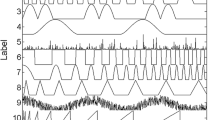Abstract
Measuring mental fatigue is essential in assessing the performance of those subjects whose careers involve severe mental activity. Recently, many analytical methods have been applied to electroencephalograms (EEGs) in order to quantitatively detect the fatigue state, but their accuracy is still not satisfactory. Factorization methods have been employed in our study to extract fatigue-related features from information captured from the ongoing raw EEG signals. The EEG signals were recorded from 32 channels from 17 healthy subjects before and after 3 h of severe mental activity. After preprocessing the raw EEGs, it was arranged in matrices to be decomposed by non-negative methods named NMF, LNMF, SNMF, DNMF, NTF, and DNTF. A comparative study of the methods was carried out by using support vector machine (SVM) (Sameni et al. in IEEE Trans Signal Process 58:2363–2374, 2010; Kadirgama et al. in Arab J Sci Eng 37:2269–2275, 2012) with extracted discriminative subspaces in order to classify raw EEGs into two “mental states” (fatigued/not fatigued). Experimental results demonstrated that discriminant DNTF outperformed (p < 0.05) the other compared non-negative methods in terms of accuracy, feature storage, and robustness.

Similar content being viewed by others
References
Dinges, D.F.; Mallis, M.M.: Managing fatigue by drowsiness detection: Can technological promises be realized? In: Hartley, L.R. (ed.) Managing Fatigue in Transportation, Proceedings of the Third International Conference on Fatigue and Transportation, Fremantle, Western Australia. Elsevier Science Ltd., Oxford, UK (1998)
Wilder-Smith, P.V.: Can SVM be used for automatic EEG detection of drowsiness during car driving? J. Saf. Sci. 47, 115–124 (2009)
Mallis, M.M.: Evaluation of Techniques for Drowsiness Detection: Experiment on Performance-Based Validation of Fatigue-Tracking Technologies. Drexel University, June (1999)
Grandjean, E.: Fatigue in industry. Br. J. Ind. Med. 36, 175–186 (1979)
Lal, S.K.L.; Craig, A.: Driver fatigue: electroencephalography and psychological assessment. Psychophysiology 39, 313–321 (2002)
Jung, T.-P.; Makeig, S.; Stensmo, M.; Sejnowski, T.J.: Estimating alertness from the EEG power spectrum. IEEE Trans. Biomed. Eng. 44, 60–69 (1997)
Dinges, D.F.: The Nature of Sleepiness: Cause, Contexts and Consequences, Perspectives in Behavioral Medicine: Eating, Sleeping and Sex. Lawrence Erlbaum, Hillsdale (1989)
Ebrhimzadeh, A.; Azimi, H.; Naeemi, H.M.: Classification of communication signals using an optimized classifier and efficient features. Arab. J. Sci. Eng. 35(1B), 225–235 (2010)
Idogawa, K.: One the brain wave activity of professional drivers during monotonous work. Behaviourmetrika 30, 23–34 (1991)
Brookhuis, K.A.; et al.: EEG energy-density spectra and driving performance under the influence of some antidepressant drugs. Drugs and driving. Taylor&Francis, London (1986)
Stutts, J.C.; Wilkins, J.W.; Vaughn, B.V.: Why Do People Have Drowsy Driving Crashes? Input from Drivers Who Just Did, Prepared for AAA Foundation for Traffic Safety (1999)
Lee, H.; Kim, Y.D.; Cichocki, A.; Choi, S.: Nonnegative tensor factorization for continuous EEG classification. Int. J. Neural Syst. 17, 305–317 (2007)
Yan, Sh.; Xu, D.; Yang, Q.; Zhang, L.; Tang, X.; Zhang, H.J.: Discriminant analysis with tensor representation. In: Proceedings of the 2005 IEEE Computer Society Conference on Computer Vision and Pattern Recognition (CVPR’05)—Volume 1–Volume 01 (CVPR ’05), Vol. 1. IEEE Computer Society, Washington, DC, USA, pp. 526–532
Lal, S.K.L.; et al.: Development of an algorithm for an EEG-based driver fatigue countermeasure. J. Saf. Res. 34, 321–328 (2003)
Jap, B.T.; Lal, S.; Fischer, P.; Bekiaris, E.: Using EEG spectral components to assess algorithms for detecting fatigue. Expert Syst. Appl. Int. J. Arch.36(2), March (2009)
Lee, D.D.; Seung, H.S.: Algorithms for non-negative matrix factorization. Adv. Neural Inf. Process. Syst. 13, 556–562 (2001)
Berry, M.; Browne, M.; Langville, A.; Pauca, P.; Plemmons, R.: Algorithms and applications for approximate nonnegative matrix factorization. Comput. Stat. Data Anal. 52(1), 155–173 (2007)
Li, S.Z.; Hou, X.W.; Zhang, H.J.: Learning spatially localized, parts-based representation. Int. Conf. Comput. Vis. Pattern Recogn. 207–212 (2001)
Buciu, I.; Pitas, I.: A new sparse image representation algorithm applied to facial expression recognition. In: Proceedings of the IEEE Workshop on Machine Learning for Signal Processing, pp. 539–548 (2004)
Zafeiriou, S.; Tefas, A.; Buciu, I.; Pitas, I.: Exploiting discriminant information in nonnegative matrix factorization with application tom frontal face verification. IEEE Trans. Neural Netw. 17(3), 683–695 (2006)
Makeig, S.; Inlow, M.: Lapses in alertness: coherence of fluctuations in performance and EEG spectrum. Electroencephal. Clin. Neurophysiol. 86, 23–35 (1993)
Brookhuis, K.A.; Waard, D.: The use of psychophysiology to assess driver status. Ergonomics 39(9), 1099–1110 (1993)
Eoh, H.J.; Chung, M.K.; Kim, S.-H.: Electroencephalographic study of drowsiness in simulated driving with sleep deprivation. Int. J. Ind. Ergonom. 35(4), 307–320 (2005)
Fisch, B.J.: Fisch and Spehlmann’s EEG Primer: Basic Principles of Digital and Analog EEG, 3rd edn. Elsevier, USA
Kruskal, J.B.: Three way arrays: rank and uniqueness of trilinear decomposition, with application to arithmetic complexity and statistics. Linear Algebra Appl. 18, 95–138 (1977)
Sameni, R.; Jutten, C.; Shamsollahi, M.B.: A deflation procedure for subspace decomposition. IEEE Trans. Signal Process. 58, 2363–2374 (2010)
Strang, G.: Linear Algebra and Its Applications. 3rd edn. Brooks/ Cole, New York (1988)
Kadirgama, K.; Noor, M.M.; Rahman, M.M.: Optimization of surface roughness in end milling using potential support vector machine. Arab. J. Sci. Eng. 37(8), 2269–2275 (2012)
Author information
Authors and Affiliations
Corresponding author
Rights and permissions
About this article
Cite this article
Razavipour, F., Boostani, R., Kouchaki, S. et al. Comparative Application of Non-negative Decomposition Methods in Classifying Fatigue and Non-fatigue States. Arab J Sci Eng 39, 7049–7058 (2014). https://doi.org/10.1007/s13369-014-1242-0
Received:
Accepted:
Published:
Issue Date:
DOI: https://doi.org/10.1007/s13369-014-1242-0




